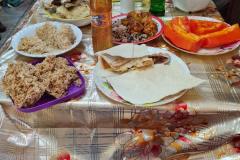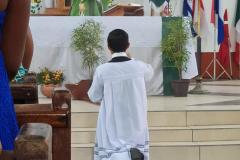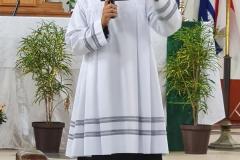GARIFUNA SPIRITUALITY CELEBRATION OF OUR ANCESTRAL SPIRITS
I Myrtle Palacio
Yesterday was a cultural participatory experience both of the Roman Catholic Church and the Garifuna culture. My ethnographic and other qualitative research techniques was quickly put to action. Today marks the 61st anniversary of the death of our beloved family matriarch Balvina Velasquez Rodriguez Cacho. In Garifuna tradition of reciprocity with our Ancestral Spirits, she along with two of her children, Victoria Cacho Herrera and Emelia Cacho Castillo were celebrated and honoured in our customary way as Garinagu. First was the bathing of our Ancestral Spirits which took place in late September, around the time of full moon; and then the mass or prayers and feasting of our Ancestral Spirits yesterday. This is a part of our spiritual beliefs as Garinagu. Yesterday the prayers were done during Mass in full Roman Catholic way, followed by the feasting and celebrations at the home.
Spiritualism is defined as a belief system whose distinguishing feature is the faith that spirits of the dead residing in the Spirit World have the ability to communicate with the living. It is a definition that can be applied to the practice of Garifuna spiritualism in Belize. Communications and exchanges between the living and the dead are hallmarks of Garifuna spiritualism, as it teaches that the spirits of dead ancestors communicate with and protect living family members in a continuing cycle of parent to child and child to parent reciprocal relationship even after death. Communication occurs during trance, when one takes on the persona of the Ancestral Spirit when alive, or via dreams of the Ancestral Spirit. Formal communication sessions or séances are held only with the Spirit Medium, the Buyei. Also, interpretations of the trance and dreams can be further clarified or articulated through séances by the Buyei.
Ancestral Spirits are reciprocated and voluntarily celebrated through various rituals, which are incorporated into day-to-day existence. As we as a family did yesterday, the activities include prayers or mass, singing, dancing and sharing of food with both the living and the dead. When the obligations to the Ancestral Spirit are overlooked or ignored then the Ancestral Spirit may as a last resort demand a formal celebration process through Adügürahani, or a Dügǘ. Dügǘ is a ceremony which consists of several rites and is by far the most elaborate and time consuming process in dispensing of commitments to the Ancestral Spirits. The ceremony takes place in a Dabuyaba led by the Buyei. Dügǘ is an option when all else fail in adhering to customary duties, and therein lies the significance—its very survival or continuity is an indication of behaviour and the resultant effect of tradition in re-instituting values to correct behaviour.
Garifuna people also embrace other belief systems such as Christianity, and as practicing Christians, have assimilated or absorbed aspects of Christian belief systems into Garifuna spiritualism. Christian images such as the cross and statues of the Virgin Mary placed on an altar in the Dabuyaba, form part of the evidence of a fusion of these belief systems. The mass yesterday at the Sacred Heart Church in Dangriga, is an example of Christian belief systems assimilated by the Garifuna people. In the mass ceremony I observed several rituals—from the elaborate dress of the Priest to the ringing of bells during the preparation for the holy communion and the smell of copal incense which permeated the church. Dügǘ is culture specific, being a tradition linked only to the Garinagu. The practice of séance (spiritual communication), via the Buyei as abovementioned, has been embraced and supported by other peoples of Belize, who have benefited greatly from this ritual.
Source: “ADÜGÜrahani: A Walk Through Garifuna Spirituality”, I. Myrtle Palacio, June 2011




